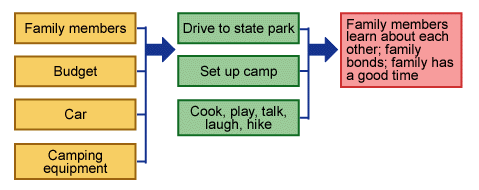Home » Enhancing Program Performance with Logic Models » Section 1: What is a Logic Model? » 1.4: Some everyday examples
1.4: Some everyday examples
Many of us use logic models in everyday life. Select each of the examples below to see how you might use a logic model.
Headache
You are suffering from a severe headache. Your experience says that certain pills help. The logic model shows that first you need to get the pills. Then you take the pills as prescribed. As a consequence, you feel better. The end result is that the headache is gone and you feel better as a result.

Hunger
Think about the times when you are hungry. What do you need? What do you want to do? First, you need to find food. Then you need to eat the food. The outcome is that you feel better once you have eaten.

Taking a vacation
This example is a bit more complex. You are planning a family camping trip. Like any family vacation, there are more inputs and outputs in order to achieve the desired outcome. Existing resources (inputs) include family members, vacation budget, car, and camping equipment. These resources make it possible to drive to a state park, set up camp, and engage in a variety of activities. As a result of camping together, we will learn more about one another, increase our bond as a family unit, and have fun.

Logic models usually depict these mental maps in a flowchart fashion of boxes and arrows. But they do not have to be linear.
You may choose to describe the components and linkages as a concept map, storyboard, or any other culturally-appropriate way. (You’ll learn more about this in Section 3 of this module.)
A logic model should be depicted in a single image, however, and communicated in a way that’s understood by intended users.




